In the face of increasing natural disasters and emergency situations, reliable and resilient energy solutions are essential. Solar kits have emerged as a crucial resource for disaster relief and emergency preparedness. Their ability to provide decentralized, clean, and reliable power makes them invaluable in critical situations. This comprehensive guide explores how solar kits can be effectively leveraged for disaster relief and emergency situations, highlighting their benefits, applications, and key considerations.

The Importance of Reliable Energy in Disasters
During disasters and emergencies, traditional energy infrastructure is often compromised, leading to widespread power outages. Reliable energy is vital for communication, medical services, food preservation, and overall community resilience.
Key Energy Challenges in Disasters
- Power Outages
- Disruption of electrical grids can last for days or weeks.
- Critical services and infrastructure are affected.
- Fuel Supply Disruptions
- Limited access to fuel for generators and vehicles.
- Increased risk of fuel shortages and transportation issues.
- Infrastructure Damage
- Damage to power lines, substations, and power plants.
- Slow restoration of traditional energy services.
Benefits of Solar Kits in Disaster Relief
Solar kits offer numerous advantages in disaster relief and emergency situations, providing a sustainable and resilient energy solution when it is needed most.
Advantages of Solar Kits
- Independence from the Grid
- Operate independently of the electrical grid.
- Provide power even when traditional infrastructure is down.
- Renewable and Sustainable
- Harness renewable solar energy, reducing the need for fuel.
- Environmentally friendly and sustainable.
- Portability and Flexibility
- Portable solar kits can be easily transported to affected areas.
- Flexible deployment in various locations and conditions.
- Quick Deployment
- Rapid installation and setup compared to traditional power systems.
- Immediate availability of power for critical needs.
- Scalability
- Can be scaled up or down based on energy requirements.
- Modular design allows for the addition of more panels and batteries.
Key Components of Solar Kits for Emergency Use
Solar kits designed for disaster relief and emergency situations typically include several essential components to ensure reliable and efficient operation.
Essential Components
- Solar Panels
- Convert sunlight into electricity.
- Available in various sizes and wattages to match energy needs.
- Battery Storage
- Stores excess energy for use during nighttime or cloudy conditions.
- Provides a reliable power supply when sunlight is unavailable.
- Charge Controllers
- Regulate the flow of electricity from solar panels to batteries.
- Prevent overcharging and extend battery life.
- Inverters
- Convert direct current (DC) from solar panels and batteries to alternating current (AC) for household and medical equipment.
- Portable Mounting Systems
- Allow for quick and flexible setup.
- Ensure optimal positioning for maximum sunlight exposure.
- Integrated Monitoring Systems
- Track energy production and consumption.
- Ensure efficient and reliable operation.
Applications of Solar Kits in Disaster Relief
Solar kits can be deployed in various ways to support disaster relief efforts and emergency preparedness.
Critical Applications
- Emergency Shelters
- Provide power for lighting, heating, cooling, and communication.
- Ensure safe and comfortable conditions for displaced individuals.
- Medical Facilities
- Power medical equipment, refrigeration for vaccines and medicines, and emergency lighting.
- Maintain critical healthcare services during power outages.
- Communication Systems
- Enable the operation of communication devices and networks.
- Ensure connectivity for coordination and information dissemination.
- Water Purification and Distribution
- Power water purification systems and pumps.
- Ensure access to clean drinking water.
- Remote and Mobile Units
- Provide energy for mobile command centers and remote operations.
- Support search and rescue missions and temporary field offices.
Best Practices for Implementing Solar Kits in Emergencies
To maximize the effectiveness of solar kits in disaster relief and emergency situations, several best practices should be followed.
Implementation Best Practices
- Pre-Deployment Planning
- Assess potential disaster risks and energy needs in advance.
- Procure and stockpile solar kits for rapid deployment.
- Training and Education
- Train emergency responders and community members in the setup and use of solar kits.
- Provide education on basic maintenance and troubleshooting.
- Regular Maintenance
- Conduct routine maintenance and testing to ensure readiness.
- Replace batteries and other components as needed.
- Collaboration with Authorities
- Coordinate with local governments, NGOs, and relief organizations.
- Integrate solar kits into broader disaster response plans.
- Scalable Solutions
- Choose solar kits that can be easily scaled to match varying energy demands.
- Ensure compatibility with additional panels and batteries.
Solar Kit Selection Table for Emergency Situations
| Feature | Small-Scale Kits | Medium-Scale Kits | Large-Scale Kits |
|---|---|---|---|
| Solar Panel Capacity | 100-500 watts | 500-2000 watts | 2000+ watts |
| Battery Storage | 1-5 kWh | 5-20 kWh | 20+ kWh |
| Ideal Applications | Small shelters, communication devices | Medical facilities, emergency shelters | Large shelters, field hospitals |
| Portability | Highly portable, easy to transport | Moderate portability | Limited portability, larger units |
| Deployment Time | Quick setup | Moderate setup time | Longer setup time |
| Typical Usage Duration | Short-term emergencies | Medium-term emergencies | Long-term relief efforts |
Conclusion
Solar kits provide a vital lifeline in disaster relief and emergency situations, offering a reliable, renewable, and independent energy source when traditional infrastructure fails. Their ability to operate independently of the grid, combined with their portability, quick deployment, and scalability, makes them an indispensable tool for emergency responders and affected communities.
By planning ahead, training personnel, and integrating solar kits into broader disaster response strategies, communities can enhance their resilience and ensure that critical services remain operational during emergencies. Leveraging solar kits for disaster relief not only addresses immediate energy needs but also contributes to long-term sustainability and environmental stewardship.
As natural disasters and emergency situations become increasingly common, the adoption of solar kits for disaster relief and emergency preparedness will play a crucial role in safeguarding lives, maintaining essential services, and promoting a sustainable future.
